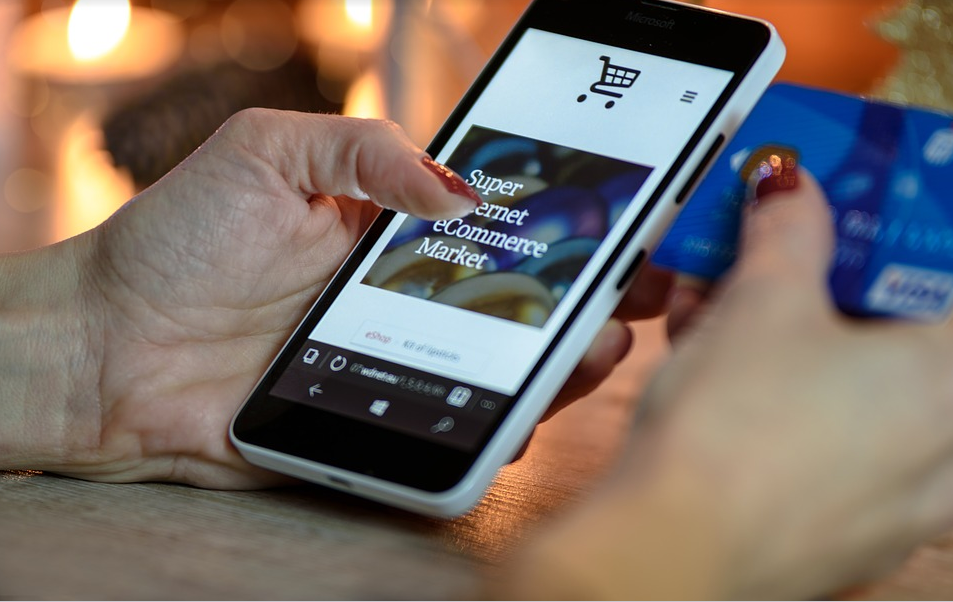What is M-Commerce? Definition and examples
M-Commerce stands for mobile commerce. The term refers to the purchasing and selling of products and services using mobile phones and other wireless handheld devices. PDA’s (personal digital assistants), for example, are handheld wireless devices.
Kevin Duffey coined the term ‘mobile commerce’ in 1997 at the launch of the Global Mobile Commerce Forum. He said: “the delivery of electronic commerce capabilities directly into the consumer’s hand, anywhere, via wireless technology. Many choose to think of Mobile Commerce as meaning ‘a retail outlet in your customer’s pocket.’”

By enabling transactions across borders with ease, m-commerce has significantly contributed to the globalization of retail.
According to the Cambridge Dictionary:
“(M-Commerce is) the business of buying and selling goods and services on the internet using a cellphone. M-commerce is short for mobile commerce.”
Spelling – capital or lowercase?
The term “m-commerce,” the short form of mobile commerce, is most commonly written in lowercase, as in “m-commerce.” When it is the first word of a sentence, we then use a capital “M,” as in: “M-commerce has grown dramatically…”
However, you will see it written in various ways, such as “m-Commerce,” or “M-commerce,” even when it is not the first word of a sentence.
Whichever style you choose, make sure you stick to it throughout an article. Don’t switch in the middle.
M-commerce and e-commerce
Some people refer to m-commerce as next-generation e-commerce. E-commerce or electronic commerce is a business model in which commercial transactions occur online, i.e., on the Internet.
Mobile commerce is a rapidly-growing part of e-commerce. Advancements in mobile payment security protocols have bolstered consumer confidence, accelerating m-commerce adoption rates. According to statista.com, global m-commerce was worth $2.2 trillion in 2023. It represented sixty percent of e-commerce sales (online sales).
Amazon has the greatest mobile reach in the United States and many other countries.

A trigger of new industries
The emergence of mobile commerce triggered many new online businesses. Below is a list of the most popular ones today:
- Mobile banking.
- Information services such as stock quotes, sports scores, news, traffic reporting, and emergency alerts.
- Location-based services.
- Electronic boarding passes.
- Mobile ticketing.
- Mobile money transfers.
- In-app payments.
- Contactless payments.
- Loyalty cards, coupons, and other mobile marketing features.
- Digital content purchases.
- Digital content delivery.
Augmented reality is revolutionizing the M-commerce experience, allowing users to visualize products in real-world settings through their mobile devices before making a purchase.
M-commerce companies target young consumers
Device sellers target teenage and young adult consumers because they use mobile phones more than any other age group. Online vendors collaborate with the major players in the telecommunications industry to promote electronic and mobile commerce so that users can shop using their smartphones.
According to Techopedia.com:
“One of the features of m-commerce sites is the adaptation of websites to make them easier to use with smaller screen sizes. There are a number of adaptations that can be made including the removal of large graphics and the optimization of fonts for easier viewing and ergonomics.”
Difference between electronic and mobile commerce
E-commerce and m-commerce have similar meanings and goals. However, they are not identical.
When people perform e-commerce activities using laptops or desktop computers, they need to find a place to buy and sell things.
With m-commerce, on the other hand, people ‘buy and sell on the go.‘ In other words, they use their mobile devices and can do their business transactions anywhere, as long as are online.
E-commerce includes any type of online commerce, i.e., using laptops, desktop computers, tablets, and smartphones. M-commerce only includes devices we carry around with us such as smartphones and perhaps also tablets. In other words, electronic commerce covers all mobile commerce activities and more.
Julia Tokareva, who works at RubyGarage, wrote:
“Usually, e-commerce activities are conducted with the help of desktop computers and laptops, so users have to look for a place to do their transactions.”
“M-commerce implies the use of mobile devices, so people can do their business transactions anywhere they go as long as they can access the internet on their smartphones and can perform transactions with just a few taps on the screen.”
M-Commerce – vocabulary and examples
There are many terms in business English that contain the word “m-commerce,” especially compound nouns. A compound noun, such as “m-commerce platform,” is a term that consists of at least two words. Let’s have a look at seven such terms, their meanings, and how we can use them in a sentence:
-
M-commerce platform
A digital marketplace accessed via mobile devices.
Example: “The new m-commerce platform allows customers to shop from their phones with ease.”
-
M-commerce transaction
A commercial exchange or purchase made using mobile technology.
Example: “Completing an m-commerce transaction has never been simpler thanks to the latest app update.”
-
M-commerce strategy
A business approach focused on buying and selling goods through mobile devices.
Example: “Our company needs to develop a comprehensive m-commerce strategy to remain competitive.”
-
M-commerce application
A mobile app designed to facilitate electronic commercial activities.
Example: “The latest m-commerce application features augmented reality to try products virtually.”
-
M-commerce analytics
The data and analysis related to mobile commerce activities.
Example: “M-commerce analytics show an increase in shopping right before holidays.”
-
M-commerce integration
The process of incorporating m-commerce into existing business models and systems.
Example: “M-commerce integration has been a key factor in the retail sector’s digital transformation.”
-
M-commerce security
Measures and protocols to ensure safe transactions in mobile commerce.
Example: “Investing in m-commerce security is essential to protect customer data and build trust.”
Video – What is M-Commerce?
This interesting video, from our sister channel in YouTube – Marketing Business Network, explains what ‘M-Commerce’ is using simple and easy-to-understand language and examples.

